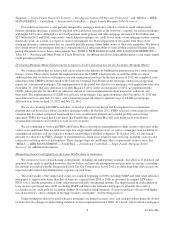Freddie Mac 2012 Annual Report Download - page 21
Download and view the complete annual report
Please find page 21 of the 2012 Freddie Mac annual report below. You can navigate through the pages in the report by either clicking on the pages listed below, or by using the keyword search tool below to find specific information within the annual report.declining rates through refinancing. When a borrower prepays a mortgage that we have securitized, the outstanding balance
of the security owned by investors is reduced by the amount of the prepayment. Unscheduled reductions in loan principal,
regardless of whether they are voluntary or involuntary, result in prepayments of security balances. Consequently, the owners
of our guaranteed securities are subject to prepayment risk on the related mortgage loans, which is principally that the
investor will receive an unscheduled return of the principal, and therefore may not earn the rate of return originally expected
on the investment.
We guarantee these mortgage-related securities in exchange for compensation, which consists primarily of a
combination of management and guarantee fees paid on a monthly basis as a percentage of the UPB of the underlying loans
(referred to as base fees), and initial upfront payments (referred to as delivery fees). We may also make upfront payments to
buy-up the monthly management and guarantee fee rate, or receive upfront payments to buy-down the monthly management
and guarantee fee rate. These fees are paid in conjunction with the formation of a PC to provide for a uniform coupon rate for
the mortgage pool underlying the issued PC.
We enter into mortgage purchase volume commitments with many of our single-family customers. These commitments
provide for the lenders to deliver to us a certain volume of mortgages during a specified period of time. Some commitments
may also provide for the lender to deliver to us a minimum percentage of their total sales of conforming loans. The purchase
and securitization of mortgage loans from customers under these contracts have pricing schedules for our management and
guarantee fees that are negotiated at the outset of the contract with initial terms that may range from one month to one year.
We call these transactions “flow” activity and they represent the majority of our purchase volumes. The remainder of our
purchases and securitizations of mortgage loans occurs in “bulk” transactions for which purchase prices and management and
guarantee fees are negotiated on an individual transaction basis. Mortgage purchase volumes from individual customers can
fluctuate significantly. If a mortgage lender fails to meet its contractual commitment, we have a variety of contractual
remedies, which may include the right to assess certain fees. Our mortgage purchase contracts contain no penalty or
liquidated damages clauses based on our inability to take delivery of presented mortgage loans. However, if we were to fail
to meet our contractual commitment, we could be deemed to be in breach of our contract and could be liable for damages in a
lawsuit. Given the uncertainty of the housing market in recent years, since 2009 we have entered into arrangements with
certain existing customers at their renewal dates that allow us to change credit and pricing terms more quickly than in the
past, including the ability to change our base management and guarantee fees upon 90 days or less notice to customers, if
directed to do so by FHFA.
We seek to issue guarantees with fee terms that we believe will, over the long-term, provide management and guarantee
fee income that exceeds our anticipated credit-related and administrative expenses on the underlying loans. To compensate us
for higher levels of risk in some mortgage products, we charge upfront delivery fees above the base management and
guarantee fee, which are calculated based on credit risk factors such as the mortgage product type, loan purpose, LTV ratio
and other loan or borrower characteristics. Historically, we have varied our guarantee and delivery fee pricing for different
customers, mortgage products, and mortgage or borrower underwriting characteristics based on our assessment of credit risk
and loss mitigation related to single-family loans.
We implemented several increases in delivery fees in recent years that are applicable to single-family mortgages with
certain higher-risk loan characteristics. Certain of these fee increases do not apply to relief refinance mortgages with LTV
ratios greater than 80% and with settlement dates on or after July 1, 2011. We have established maximum limits on the
amount of delivery fees that are imposed for relief refinance mortgages, regardless of the LTV ratio of the loan.
We also implemented two across-the-board increases in guarantee fees in 2012. Effective April 1, 2012, at the direction
of FHFA, both we and Fannie Mae increased the guarantee fee on single-family residential mortgages sold to us by 10 basis
points. Under the Temporary Payroll Tax Cut Continuation Act of 2011, the proceeds from this increase are being remitted to
Treasury to fund the payroll tax cut. We pay these fees to Treasury on a quarterly basis and refer to this fee increase as the
legislated 10 basis point increase in guarantee fees. In the fourth quarter of 2012, both we and Fannie Mae implemented, at
FHFA’s direction, a further increase in guarantee fees on single-family mortgages of an average of 10 basis points. In
announcing this increase, FHFA stated that the changes to the guarantee fee pricing represent a step toward encouraging
greater participation in the mortgage market by private firms.
In September 2012, FHFA also requested public comment on a proposed approach under which we and Fannie Mae
would adjust our delivery fees charged on single-family mortgages in states where costs related to foreclosures are
statistically higher than the national average. FHFA stated in its September 2012 announcement that it expects to direct us
and Fannie Mae to implement the pricing adjustments in 2013.
16 Freddie Mac
























